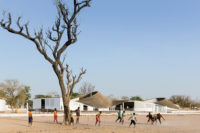Henan Province, China
Located in a mountainous part of central China's Henan Province, Xihe was always a small, quiet village that subsisted on growing corn, grains, and tea seeds for oil. But by the time architect He Wei first visited in 2013, it was on life support, having dwindled to just 150 residents—almost all children and elderly farmers.
Invited through a government rural-poverty-alleviation program, He, an architecture professor at Beijing's Central Academy of Fine Arts, examined Xihe's prospects. Though dotted with historic structures amid a pleasant landscape, it didn't quite have the picturesque charm that has turned many once-sleepy Chinese villages into tourist attractions. In a country with well over a billion registered mobile phone users, it didn't even have cellular coverage. What it did have, however, was a 1950s granary complex on the south end of town that He, working with local residents, has retooled as the Xihe Cereals and Oils Museum and Villagers' Activity Center.
Set beside a stream, the compound consists of five pitched-roof masonry buildings clustered around a courtyard. The small complex now serves a range of community needs while luring newly minted urbanites with the attraction of fast-disappearing rural life—an example of how quickly China has come full circle.
He began by converting a 4,500-square- foot warehouse into a museum that shows the use of traditional millstones, oil presses, and other implements. Across the courtyard, the architect turned a 7,300-square-foot building into an activity center for village meetings, weddings, and other events, and outfitted one end of it as a shop selling locally made tea-seed oil and organic foods that appeal to a Chinese citizenry wary from the country's food-safety scandals. A smaller building was attached to form a restaurant, while the remaining two buildings function as a kitchen and an office.
Throughout, He wanted to maintain as much of the original structures as possible—“to keep the history,” he explains. So he left interior brick floors, timber framing, and plastered walls intact. Painted Chinese characters dating to the Cultural Revolution were retained, as was the concrete paving of the courtyard (now doubling as a playground), despite an early government request to “upgrade” it to brick.
The architect's interventions are subtle, but make a big difference. He opened up the north side of the activity center to create expansive views across a terrace reconstructed with repurposed roof tiles. Bamboo screens shield floor-to-ceiling glazing here and are repeated on the museum's south elevation. Connecting both buildings, a zigzagging outdoor corridor (also of bamboo) helps define the courtyard, where a fire protection pond was turned into a water feature. Inside the activity center, pivoting bamboo partitions separate the main hall from spaces for the restaurant.
For He, this was not a parachute job, but resulted from lengthy discussions with the initially skeptical villagers. “We listened to them and gained their trust,” says the architect, and eventually they contributed both funding and labor. Income from the restaurant, space rentals, and sales of food products, including a new Xihe Oil branded by He, go to the village cooperative. The result appears to be a success. With the aid of publicity campaigns, 20,000 visitors came to Xihe over China's National Day holiday in 2014—“more than even we expected,” He says.
PeopleClient: Villager Cooperative of Xihe Village Owner: Villager Cooperative of Xihe Village
Architect:
Personnel in architect's firm who should receive special credit: Architect of record: HE Wei Associate architect: CHEN Long Interior designer: HE Wei, CHEN Long Engineers: HE Wei, CHEN Long and Villagers from Xihe
Consultant(s):
Lighting: QI Honghai (Z DESIGN&PLANNING), HAN Xiaowei (Geston) Other: Exhibition Designer: ZHAO Zhuoran; Graphic Designer: XIA Boyang General contractor: Villager Cooperative of Xihe Village Photographer(s): HE Wei, QI Honghai, CHEN Long Size: 16,500 square feet Cost: $240,000 Completion date: July 2014 |
Products
Structural system Manufacturer of any structural components unique to this project: All materials (except steel and glass) are local materials.
Lighting Downlights: Nanjing GAIN Lighting Technology Co., Ltd. Task lighting: Nanjing GAIN Lighting Technology Co., Ltd. Exterior: Nanjing GAIN Lighting Technology Co., Ltd. Dimming System or other lighting controls: Nanjing GAIN Lighting Technology Co., Ltd. |













